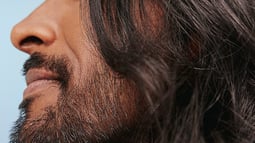

Comb, brush or hand: which tool should you use to style your hair?
Photos Abaca
Words Axel Yvon
Share the article on
More #teamcomb or #teambrush?
Who hasn’t stood in front of a mirror, not knowing what to pick among the various accessories – possible instruments of torture – that can help us fix our hair? Which is better, comb or brush? But the two can also work together, and it is necessary to distinguish their unique uses. Let’s clear the subject up!
Why is it important to brush/comb our hair?
For starters, let’s remember that hair is alive. Yes, like your skin, which we invigorate and hydrate (with our mattifying moisturiser, for example) the hair must be nourished and maintained if we want it to appear healthy and strong. To do this, several tips exist: wash your hair regularly but not daily, adopt a food plan rich in vitamins A, B, and C; add iron and zinc, and if necessary, other food supplements, and moisturise the hair as often as possible.
Take advantage of your shower (or bath, your choice) to use a detangling product that can soften your hair for better results when styling. A conditioner works. Brushing or combing your hair helps ventilate the follicles, which aids in removing impurities after a long day.
It also helps distribute sebum – which the sebaceous glands below the skull product, along the length of the hair follicle. This is what guarantees shine and protection! Not bad, eh? Proper brushing stimulates blood circulation in the scalp which allows your hair to grow faster and stronger thanks to the nutrients that flow through the blood. Don’t be too harsh, as irritation will lead to dandruff, which will excessively grease your hair.
Who brushes?
Depending on the nature and type of hair, the use of a brush is more or less recommended.
Logically, we will only choose a brush with soft bristles for finer hair. The thicker the hair, the more you can use a brush with coarse bristles.
The brush is to be avoided if you have curly or frizzy hair, but is still an ally for fine, wavy locks, which must be combed gently and regularly. Brushing hair allows it to breathe, especially if long.
Avoid brushing your hair directly out of the shower when wet. It gets weakened when softened by heat (unless you like cold showers) and damp. Pulling too eagerly will draw hair into your hands. For lovers of treatments, know that a brush is an excellent way to distribute evenly around your mane. You can even place a few drops of essential oils – those of ylang ylang and geranium do the trick – on the brushes to nourish from root to tip.
And the comb?
The comb is commonly used to style and disentangle hair. As with the brush, there are several types to choose from. Among them, we find the wider teeth combs, adapted to curly or frizzy hair. This has the advantage of fuller locks and avoiding breakage on more fragile hair. The finer the hair, the more you will rely on a comb that has narrow, thin teeth to prevent damage.
You can use your comb in the shower, while applying treatments like conditioner over the entire length of your hair. To do this, add just a small amount of product on the comb, so that it is applied evenly with each movement. Using it like this should prove to be a success.
Can I just use my fingers?
Actually the instinctive use of your fingers will untangle your hair, without forcing a few tough-to-break knots. Even without the precision of a brush or comb, your fingers will be useful in correcting the final details of a style, like a misplaced curl or flatness. When you want to untangle still-wet hair (for lack of time or even laziness) it’s better to choose your hands over a comb or brush, at the risk of seriously damaging your clean and damp hair. Which is obviously more fragile. Either way, remember it is still better to have a comb or brush on hand.
How to choose the right accessory
As is often the case, investing in a good product will guarantee easier-use, durability, and efficiency. For the comb, models made with horn, resin, or wood have the advantage of not damaging the hair, or leaving static. We must also avoid plastic combs. Produced industrially, these are often removed from their mold covered with small imperfections which, with each use, risk damaging the fiber of your hair.
When it comes to the brush there are two main types. The first, with tighter and flexible hair strains, and the second for coarser hair.
To avoid creating too much static – and the dreaded Lion’s Mane effect – we suggest brushes made of boar bristle, or for conservationists, brushes made with natural silk bristles (designed, for example, with agave). Their hair-like composition, including keratin, allows you to soften your mass of hair, nourish it, and leave it silky without any damage.
With plenty of bad choices online, know that a brush of this calibre is often at a minimum of £25. To recognize a real boar bristle brush, observe the hairs – which should be flexible and light in colour. The more daring will be able – at their own risk – to pass some fire over the brush, which should leave a natural odor of burnt hair. You will know immediately whether it is real wild boar hair or synthetic.
Finding a good accessory is not easy when you don’t know where to look. So for those in a hurry, check out brands like Mason Pearson, Thomas Liorac, Hydrea London, Artisan Brossier France ou Less is More, all offering beautiful solid examples with real quality.
For those of you who have dreamed of sporting Elvis’s famous hairstyle, the perfect blow-dry of James Dean, or the silky cut Johnny Depp wore in the 90s, now you know what to do!












